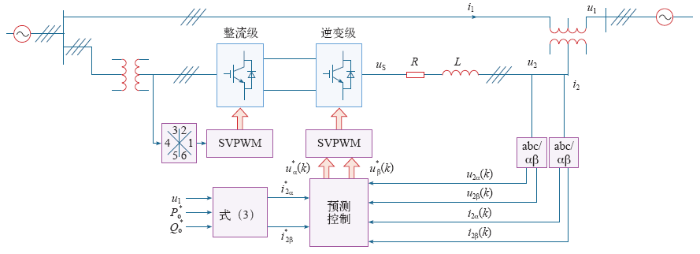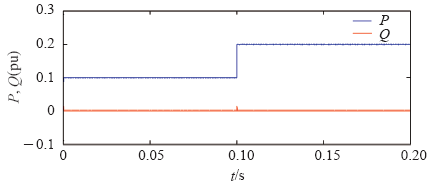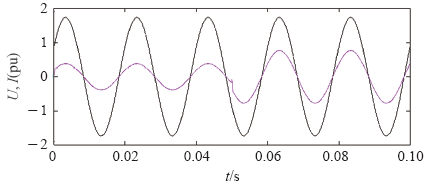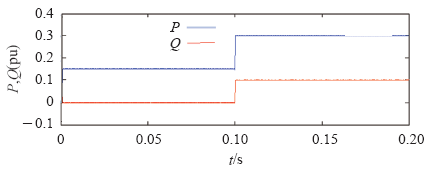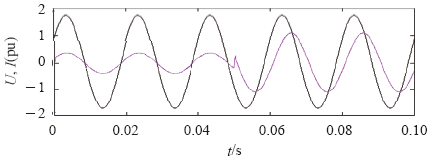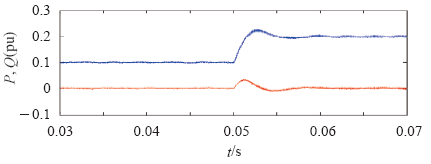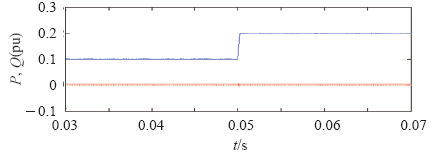1 引言
双级矩阵变换器(Two-Stage Matrix Converter,TSMC)是最近几年在(Conventional Matrix Converter,CMC)基础上发展起来的一种新型拓扑结构的矩阵变换器。TSMC具有结构简单、结构紧凑、能量可双向流动、可产生正弦输入电流和输出电压及输入功率因数角可调等优点,无须采用CMC复杂的4步换流法。由于上述优点,TSMC在UPFC中具有较大的应用价值[5]。
预测控制处理复杂非线性、时变性和不确定性系统,建模方便,具有控制精度高、算法简单、对模型要求低等优点,能提高系统的鲁棒性,具有较好的动态控制效果。本文将预测算法引入TSMC-UPFC控制系统中,首先分析了TSMC的双空间矢量调制策略,接着建立了TSMC逆变级的预测模型,在此基数上提出了TSMC-UPFC串联侧逆变级的电流预测控制策略,最后建立了仿真模型对控制策略进行验证。仿真结果表明:所提控制策略有效地提高了TSMC-UPFC系统潮流控制的动静态性能,从而验证了所提控制策略的有效性[12]。
2 TSMC-UPFC电路结构及原理
图1
3 TSMC调制策略
UPFC中,TSMC整流级主要作用是给逆变级提供直流电压,为了防止逆变级开关上、下直通事故,要求整流级输出电压极性保持为正。
可以把输入三相电压的每一个周期都划分为六个区间,如图2所示。使每一个区间都有具有相同的特点:其中有一相的电压绝对值最大,另外两相电压的极性与之相反。
图2
将每个PWM调制周期分为两个部分,并分别在这两段时间内,将对应的两个极性为正且绝对值最大的线电压由直流侧输出,构成线电压的两个相电压瞬时比值即为每个线电压占空比。以第二区间为例,两个线电压分别为ubc、uac,对应的占空比计算公式为

在TSMC整流级在一个PWM周期内输出两级电压,以第二区间为例,一个PWM周期内整流级输出的电压在两时间段分别为ubc、uac,且开关频率大大高于输入电压频率,因此在一个PWM周期内的两个线电压可以看成常量,逆变级可以看作是在两时间段分别由ubc、uac供电的电压源逆变器。
图3
设VJ为某一瞬间的输出线电压空间矢量,它落在六边形空间矢量中的某个区域内,其相对应两有效空间矢量为VM和VN,则VJ可由矢量VM和VN合成,其关系式为


式中,m0是逆变级的调制系数;θ是VJ和VM的夹角;dN、dM、d0分别是VM、VN、V0(零电压矢量)的占空比。在进行整流级零电流换流的情况下,可以将各时间段的开始和结尾部分时间分配给逆变级的零电压矢量,则TSMC在一个PWM周期内整流级和逆变级开关的协调控制如图4所示。
图4
图4
两个时间段直流电压和开关矢量
Fig.4
The DC voltage in two portions and switchingvector sequence
4 TSMC串联侧逆变级的电流预测控制策略
4.1 线路潮流控制原理
在两相静止坐标下,根据瞬时功率理论,主线路上的有功功率和无功功率为

式中,u1α和u1β是线路母线电压值u1在静止坐标系下的α和β分量;i1α和i1β是线路电流值i1在静止坐标系下的α和β分量;po和qo分别是线路有功功率和无功功率。
考虑到母线电流和串联逆变器电流的关系,有

式中,n1和n2分别是串联变压器的一次侧和二次侧的电压比。
从而由式(4)和式(5)的关系可以得到

则由式(6)反变换可得

设给定有功功率和无功功率的参考值为po*和qo*,式(7)可得参考电流表达式为

由式(8)可知,通过控制TSMC逆变级输出侧电流(串联变压器二次电流),从而改变一次侧的节点电压,可以实现对线路潮流进行控制。根据式(8)和给定潮流(线路参考有功功率和无功功率)可以求得逆变级参考电流。
4.2 预测电流控制策略
由KVL定理可得TSMC输出端的电压方程为

式中,u2表示网侧输入电压;us表示逆变级输出电压;i2表示逆变级输出电流;R和L分别表示逆变级输出侧滤波电路的电阻和电感。在αβ坐标系下,式(9)可以表示为
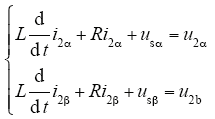
设采样周期为Ts,式(10)经离散化,得


式中,i2α(k + 1)和i2β(k + 1)分别指第k + 1次采样周期时输入电流的采样值,这里分别用给定值i*2α和i*2β来代替,可得

图5
TSMC与主电路并联的整流级采用空间矢量调制,把输入相电压作为调制信号,为逆变级提供直流电压,提供其所需要的有功功率。
5 仿真分析
利用Matlab/Simulink搭建TSMC-UPFC的系统模型。主要仿真参数如下:系统电网相电压为10kV,电网角频率为50Hz;线路中等效电阻为0.5Ω,电感为1mH;UPFC的并联部分(整流级)接入电网的并联变压器为Yd接法,一次、二次侧电压比为2.5∶1;UPFC的串联部分(逆变级)接入电网的串联变压器为Yd接法,一次、二次侧电压比为6∶8;输出滤波器的电感为1mH,电路等效电阻为0.03Ω。设定功率基准值为10MW。
图6
图7
图8
图9
图10
图10
采用PI 控制的系统有功功率和无功功率波形
Fig.10
Waveforms of power waveforms under PI control
图11
6 结论
本文分析了TSMC双空间矢量调制策略,建立了UPFC中TSMC逆变级的数学模型,在此基础上提出了UPFC串联侧的TSMC逆变级的电流预测控制策略。该控制方法使得有功功率和无功功率独立控制,较好地实现了解耦,系统具有较好的动静态性能,且控制简单灵活,便于数字化实现。
参考文献
统一潮流控制器多目标协调控制策略研究
[J].
DOI:10.13335/j.1000-3673.pst.2014.04.028
URL
[本文引用: 1]

As for the unified power flow controller (UPFC) applied in power grid there are multi control objectives as adjusting line power flows, maintaining bus voltages, improving transient stability and so on, however the implementation of these objectives are not entirely uniform. When UPFC adopts the control strategy for a certain objective, the requirements of multi operating conditions cannot be satisfied, for this reason, the implementing principles and control methods of UPFC’s different control objectives are analyzed and the relationship among these objectives and the reason causing the inconsistency among them are expounded, on this basis, a multi-objective coordinated control strategy is proposed and utilizing fuzzy logic an auxiliary controller, by which the magnitude of additional signal can be adaptively adjusted according to operating conditions of power grid and then the coordinated control among multi-objectives can be implemented, is designed. The proposed control strategy makes the voltage and line power flows enable to rigorously track the reference value during steady state operation of power grid, and after the occurrence of transient disturbance the transient stability limit can be farthest maximized while the system voltage and line power flows can be maintained within allowed ranges, meanwhile the system damping can be increased and the system oscillation can be rapidly suppressed. The correctness of theoretical analysis and effectiveness of the proposed coordinated control strategy are validated by results of PSCAD/EMTDC based simulation of a two-area four-machine system.
Study on multi-objective coordinated control strategy of unified power flow controller
[J].
DOI:10.13335/j.1000-3673.pst.2014.04.028
URL
[本文引用: 1]

As for the unified power flow controller (UPFC) applied in power grid there are multi control objectives as adjusting line power flows, maintaining bus voltages, improving transient stability and so on, however the implementation of these objectives are not entirely uniform. When UPFC adopts the control strategy for a certain objective, the requirements of multi operating conditions cannot be satisfied, for this reason, the implementing principles and control methods of UPFC’s different control objectives are analyzed and the relationship among these objectives and the reason causing the inconsistency among them are expounded, on this basis, a multi-objective coordinated control strategy is proposed and utilizing fuzzy logic an auxiliary controller, by which the magnitude of additional signal can be adaptively adjusted according to operating conditions of power grid and then the coordinated control among multi-objectives can be implemented, is designed. The proposed control strategy makes the voltage and line power flows enable to rigorously track the reference value during steady state operation of power grid, and after the occurrence of transient disturbance the transient stability limit can be farthest maximized while the system voltage and line power flows can be maintained within allowed ranges, meanwhile the system damping can be increased and the system oscillation can be rapidly suppressed. The correctness of theoretical analysis and effectiveness of the proposed coordinated control strategy are validated by results of PSCAD/EMTDC based simulation of a two-area four-machine system.
Direct power control for universal power flow controller series converter
[J].
A novel structure of UPFC with matrix converter
[J].
A UPFC based on matrix converter
[J].
DOI:10.1016/j.ajo.2019.12.012
URL
PMID:31883463
[本文引用: 1]

To identify predictors of bubble formation and type during big-bubble deep anterior lamellar keratoplasty (BB-DALK) performed in keratoconus at different stages of severity.
Design and simulation of unified power flow controllers using matrix converters
[J].
矩阵变换器在统一潮流控制器中的应用
[J].
Application of matrix converter in unified power flow controller
[J].
基于双级矩阵变换器的统一潮流控制器设计
[J].
DOI:10.3748/wjg.v21.i8.2395
URL
PMID:25741147
[本文引用: 1]

To investigate the efficacy and safety of transarterial chemoembolization (TACE)-based multimodal treatment in patients with large hepatocellular carcinoma (HCC).
Design of unified power flow controller based on two-stage matrix converter
[J].
DOI:10.3748/wjg.v21.i8.2395
URL
PMID:25741147
[本文引用: 1]

To investigate the efficacy and safety of transarterial chemoembolization (TACE)-based multimodal treatment in patients with large hepatocellular carcinoma (HCC).
Matrix converter based unified power flow controllers: advanced direct power control method
[J].
DOI:10.1109/TPWRD.2010.2055897
URL
[本文引用: 1]

This paper presents a direct power control (DPC) for three-phase matrix converters operating as unified power flow controllers (UPFCs). Matrix converters (MCs) allow the direct ac/ac power conversion without dc energy storage links; therefore, the MC-based UPFC (MC-UPFC) has reduced volume and cost, reduced capacitor power losses, together with higher reliability. Theoretical principles of direct power control (DPC) based on sliding mode control techniques are established for an MC-UPFC dynamic model including the input filter. As a result, line active and reactive power, together with ac supply reactive power, can be directly controlled by selecting an appropriate matrix converter switching state guaranteeing good steady-state and dynamic responses. Experimental results of DPC controllers for MC-UPFC show decoupled active and reactive power control, zero steady-state tracking error, and fast response times. Compared to an MC-UPFC using active and reactive power linear controllers based on a modified Venturini high-frequency PWM modulator, the experimental results of the advanced DPC-MC guarantee faster responses without overshoot and no steady-state error, presenting no cross-coupling in dynamic and steady-state responses.
统一潮流控制器控制策略的研究与实现
[J].
Control scheme and implement of a unified power flow controller
[J].
Predictive control of an indirect matrix converter
[J].
18开关双级矩阵变换器的空间矢量调制策略及其仿真研究
[J].
Space vector modulation strategy of two-stage matrix converter with 18 switches and it’s simulation study
[J].
三相Boost 并网逆变器的离散时间预测控制
[J].三相Boost并网逆变器工作在直流输入电压小于电网电压峰值的场合,具有输入电压调节范围宽的优良特性,适合用于燃料电池、光电池等可再生能源系统的单级并网发电。提出一种三相Boost并网逆变器网侧电流的离散时间预测控制。该方法在每一个采样周期内,利用逆变器输出电流的离散时间模型和逆变器产生的7种电流空间矢量,预测逆变器下一个采样周期的网侧电流,并以该电流与理想网侧电流的误差最小作为优选指标,确定下一个采样周期的开关信号。该方法不需要传统Boost逆变器控制中的任何调制策略,方法简单,实现容易。实验结果表明,采用离散时间预测控制的三相Boost逆变器并网系统具有优良的并网性能。
Discrete-time predictive control of three-phase boost grid-connected inverter
[J].三相Boost并网逆变器工作在直流输入电压小于电网电压峰值的场合,具有输入电压调节范围宽的优良特性,适合用于燃料电池、光电池等可再生能源系统的单级并网发电。提出一种三相Boost并网逆变器网侧电流的离散时间预测控制。该方法在每一个采样周期内,利用逆变器输出电流的离散时间模型和逆变器产生的7种电流空间矢量,预测逆变器下一个采样周期的网侧电流,并以该电流与理想网侧电流的误差最小作为优选指标,确定下一个采样周期的开关信号。该方法不需要传统Boost逆变器控制中的任何调制策略,方法简单,实现容易。实验结果表明,采用离散时间预测控制的三相Boost逆变器并网系统具有优良的并网性能。
风力发电并网逆变器预测电流控制方法研究
[J].
Research on predicted current control for grid inverter in wind power generation
[J].
Predictive current control with reactive power minimization in an indirect matrix converter
[C].






